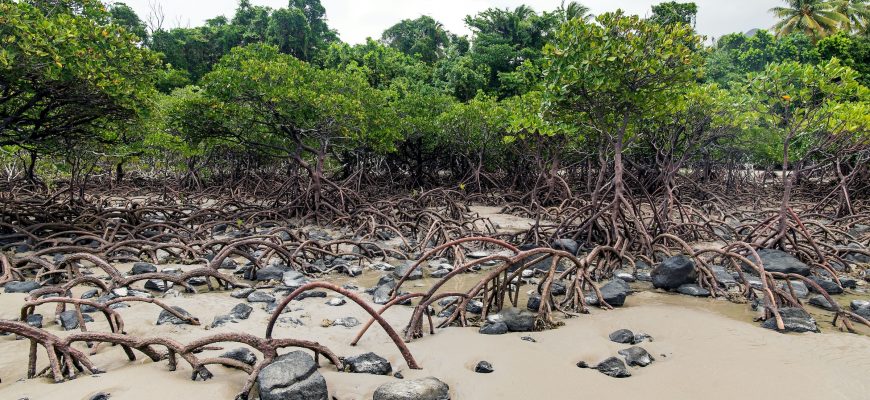
In 2019, stakeholders from state and local governments, nongovernmental conservation organizations, and the travel tourism industry of Quintana Roo, Mexico came together to form the Coastal Zone Management Trust. This intergovernmental collaboration had one goal, to buy a parametric insurance policy designed to protect the northern Mesoamerican Barrier Reef from the damaging effects of hurricanes.
Healthy coral reefs can reduce up to 97% of wave energy which diminishes hurricane-related storm surges and beach erosion. For Quintana Roo, protecting the Mesoamerican Barrier reef is vital to the health and well-being of its residents and the travel tourism industry which generates a half billion USD each year.
Parametric insurance policies for nature-based infrastructures like coral reefs are a novel approach for insuring against natural disasters and supply a multitude of benefits to communities. Because these policies payout based on the parameters of weather events, insurance companies rely on measurements from third-party government organizations such as the NOAA or USGS. Payouts are received within days or weeks versus months or years compared to a traditional indemnity policy.
This novel intergovernmental approach prevents loss of life, habitat, and economy while increasing community resilience and diversifying disaster relief funds. Insurance companies win too, they do not have to send in fleets of adjusters to decide the actual cost value of loss and parametric insurance policies remove moral hazards and fraud from the underwriting equation.1 All of which translates to reduced costs and solving governmental challenges.
As the United States begins recovery efforts from Hurricanes Fiona and Ian, stakeholders in coastal tropical and sub-tropical communities ought to consider mangrove forests as another nature-based infrastructure fit for parametric insurance. Like coral reefs, mangroves can reduce 93-98% of wave energy2 and have the potential to increase soil surface elevation along coastlines that keeps pace with rising sea-level forecasts through a process called sub-surface expansion.
Seeding and keeping mangrove forests have added benefits that contribute to community disaster resilience. First, mangroves reach maturity in two years, and they are cost-effective compared to other nature-based infrastructures or other manufactured flood risk reduction strategies like levies. For example, a hectare of mangroves costs $45,000 in the continental United States and only $23,000 in the Caribbean which is 3.6 times lower than the median costs associated with keeping and repairing coral reefs, salt marshes, and oyster reefs.3 In communities where mangroves grow, this has the potential to save billions of dollars, can be fully repaired years before manufactured infrastructure projects are shovel-ready, and positively contributes to ecological diversity.
Being one of the most carbon-dense plants on Earth, mangrove forests also serve an added benefit in the form of carbon sequestration or “Blue Carbon”4. Organizations like the Louisiana Land and Exploration Company, a subsidiary of ConocoPhillips has capitalized on this trait by transforming 636,000 acres of land in Southeast Louisiana into a sequestration mangrove forest, scrubbing carbon dioxide from the atmosphere and lessening the impacts of climate change.
With climate change and disaster resilience being one of the most pressing issues in federal, state, local, tribal, and territorial governments, intergovernmental models of collaboration are vital to using parametric insurance policies for nature-based infrastructures. If you would like to explore case studies on parametric insurance efficacy, look at the Caribbean Catastrophe Risk Insurance Fund, African Risk Capacity, and Insure8.
- Horton, JB. “Parametric Insurance as an Alternative to Liability for Compensating Climate Harms.” Carbon & Climate Law Review 12, no. 4 (2018): 285–96. https://doi.org/10.21552/cclr/2018/4/4.
- K G, Parvathy, and Prasad K Bhaskaran. “Wave Attenuation in Presence of Mangroves: A Sensitivity Study for Varying Bottom Slopes.” The International Journal of Ocean and Climate Systems 8, no. 3 (2017): 126–34. https://doi.org/10.1177/1759313117702919.
- Bayraktarov, Elisa, and Megan Irene Saunders. “The Cost and Feasibility of Marine Coastal Restoration.” Ecological Applications, 2015. https://doi.org/10.1890/15-1077.1.
- Jakovac, Catarina C. “Costs and Carbon Benefits of Mangrove Conservation and Restoration: A Global Analysis.” Ecological Economics 176 (2020): 106758. https://doi.org/10.1016/j.ecolecon.2020.106758.
